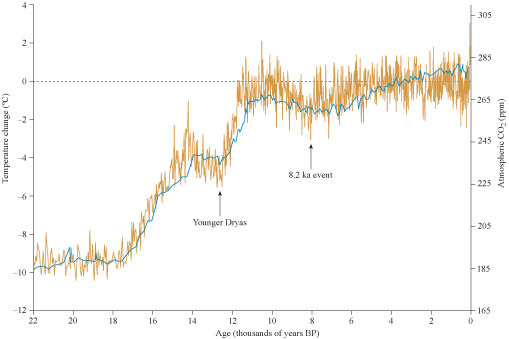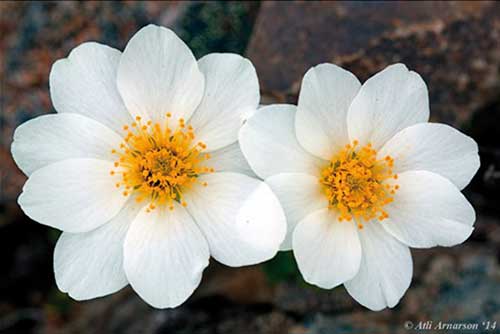4 The end of the last ice age: the Holocene
As noted earlier, the great ice sheets took about 100 000 years to grow and only about 10 000 years to decay. So what happened at the end of the last ice age? Figure 19 shows the EPICA ice core CO2 concentration and Antarctic air temperature for the most recent 20 000 years, which is within the last ice age. The temperature scale shows the difference from the average temperature of the last 1000 years, so 0 °C represents no change from (fairly) recent climate.

Figure 19 shows again the high correlation between the two variables: 20 000 years ago it was up to 10 °C colder in Antarctica, and global CO2 concentration was more than 200 ppm lower than today. Over the most recent 10 000 years the temperature was within about 2 °C of current temperatures, and this climatically stable time period is called the Holocene. Figure 18 shows that such a warm, stable period has been very unusual in the last 800 000 years, yet it is only during the Holocene that agriculture and the civilisations that rely on it have developed. Homo sapiens has flourished in the stable climate era.
Figure 19 shows that up to approximately 14 000 years ago the planet appeared to be leaving the ice age, and Antarctic temperatures rose to within 1 °C of the 0 °C line. But then there was a very rapid cooling of 4–5 °C (and most of this in just a couple of decades), and lower temperatures resumed from 12 900 to 11 600 years before the present. This cold period affected most of the planet and is called the Younger Dryas, after a pretty Arctic alpine flowering plant called the white dryas (Figure 20). This species spread its geographical range as temperatures fell and the tundra biome expanded in area.

Another interesting event shown in Figure 19 happened just before 8000 years ago (called the ‘8.2 ka event’ where ‘ka’ is an abbreviation meaning 1000 years), when there was a definite but relatively small temperature and CO2 decrease which was associated with drier conditions in some parts of the world. This represents the largest climatic variation that civilisation has currently had to cope with.
So what happened in the Younger Dryas and 8000 years ago to make the planet suddenly colder? The changes occurred too fast for the Milankovitch cycle to be responsible. It is now believed that the only way to cause that much cooling is by a sudden change in part of the global ocean circulation. Just as there are global patterns of air circulation, so there are also much slower, but enormous, movements of water around the oceans, driven by changes in water temperature and salinity, which you will look at next.
